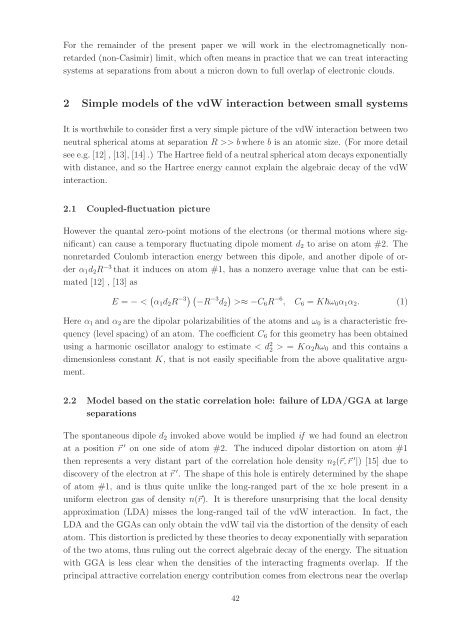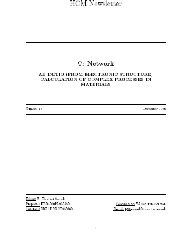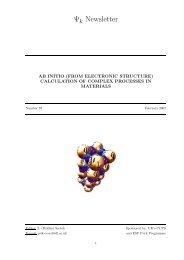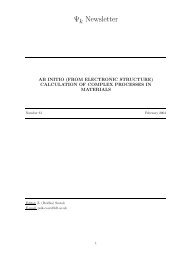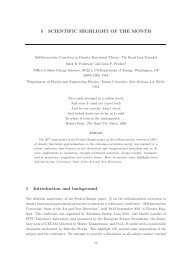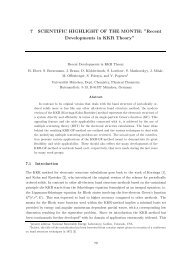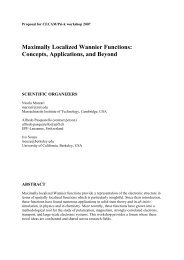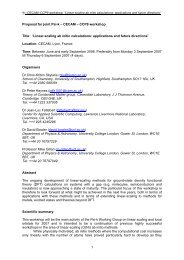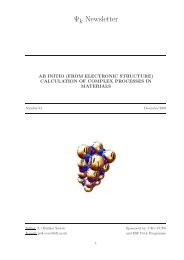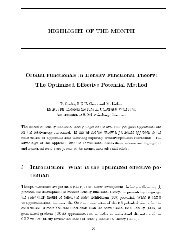Newsletter 107 - October 2011 - (pdf - 0.6 MB) - Psi-k
Newsletter 107 - October 2011 - (pdf - 0.6 MB) - Psi-k
Newsletter 107 - October 2011 - (pdf - 0.6 MB) - Psi-k
You also want an ePaper? Increase the reach of your titles
YUMPU automatically turns print PDFs into web optimized ePapers that Google loves.
For the remainder of the present paper we will work in the electromagnetically nonretarded<br />
(non-Casimir) limit, which often means in practice that we can treat interacting<br />
systems at separations from about a micron down to full overlap of electronic clouds.<br />
2 Simple models of the vdW interaction between small systems<br />
It is worthwhile to consider first a very simple picture of the vdW interaction between two<br />
neutral spherical atoms at separation R >> b where b is an atomic size. (For more detail<br />
see e.g. [12] , [13], [14] .) The Hartree field of a neutral spherical atom decays exponentially<br />
with distance, and so the Hartree energy cannot explain the algebraic decay of the vdW<br />
interaction.<br />
2.1 Coupled-fluctuation picture<br />
However the quantal zero-point motions of the electrons (or thermal motions where significant)<br />
can cause a temporary fluctuating dipole moment d 2 to arise on atom #2. The<br />
nonretarded Coulomb interaction energy between this dipole, and another dipole of order<br />
α 1 d 2 R −3 that it induces on atom #1, has a nonzero average value that can be estimated<br />
[12] , [13] as<br />
E = − < ( α 1 d 2 R −3)( −R −3 d 2<br />
)<br />
>≈ −C6 R −6 , C 6 = Kω 0 α 1 α 2 . (1)<br />
Here α 1 and α 2 are the dipolar polarizabilities of the atoms and ω 0 is a characteristic frequency<br />
(level spacing) of an atom. The coefficient C 6 for this geometry has been obtained<br />
using a harmonic oscillator analogy to estimate < d 2 2 > = Kα 2ω 0 and this contains a<br />
dimensionless constant K, that is not easily specifiable from the above qualitative argument.<br />
2.2 Model based on the static correlation hole: failure of LDA/GGA at large<br />
separations<br />
The spontaneous dipole d 2 invoked above would be implied if we had found an electron<br />
at a position ⃗r ′ on one side of atom #2. The induced dipolar distortion on atom #1<br />
then represents a very distant part of the correlation hole density n 2 (⃗r,⃗r ′ |) [15] due to<br />
discovery of the electron at ⃗r ′ . The shape of this hole is entirely determined by the shape<br />
of atom #1, and is thus quite unlike the long-ranged part of the xc hole present in a<br />
uniform electron gas of density n(⃗r). It is therefore unsurprising that the local density<br />
approximation (LDA) misses the long-ranged tail of the vdW interaction. In fact, the<br />
LDA and the GGAs can only obtain the vdW tail via the distortion of the density of each<br />
atom. This distortion is predicted by these theories to decay exponentially with separation<br />
of the two atoms, thus ruling out the correct algebraic decay of the energy. The situation<br />
with GGA is less clear when the densities of the interacting fragments overlap. If the<br />
principal attractive correlation energy contribution comes from electrons near the overlap<br />
42


